by Brian Hioe
語言:
English
Photo Credit: Hung Hsiu-chu/Facebook
THE FACT THAT Hung Hsiu-Chu’s meeting with Xi Jinping in Beijing has largely been a non-event in Taiwan probably attests to its futility. Given that Hung is already known for outlandishly extreme pro-unification views, Hung’s meeting with Xi probably does not really surprise the Taiwanese public, in the way that Eric Chu’s or Ma Ying-Jeou’s meetings with Xi Jinping in 2015 provoked stronger reactions. Hence the lack of any real public response. But does the Hung-Xi meeting indicate anything new?
Hung’s meeting with Xi takes place through the auspices of yearly interparty meetings between the KMT and CCP which have taken place since 2005, with Hung and Xi meeting in their capacities as chairpersons of the KMT and CCP respectively. Such meetings are conducted on the basis of the so-called “special historical relationship” of the KMT and CCP. Namely, the historical animosity of the KMT and CCP dating back to the defeat of the KMT during the Chinese Civil War, which led to its flight to Taiwan, has given way to shared interests in achieving the unification of Taiwan and China. Seeing as the KMT retaking China by force has become impossible, the ideological priority of KMT diehards has become achieving unification in any form, something which goes hand-in-hand with a rosy view of Chinese authoritarianism.
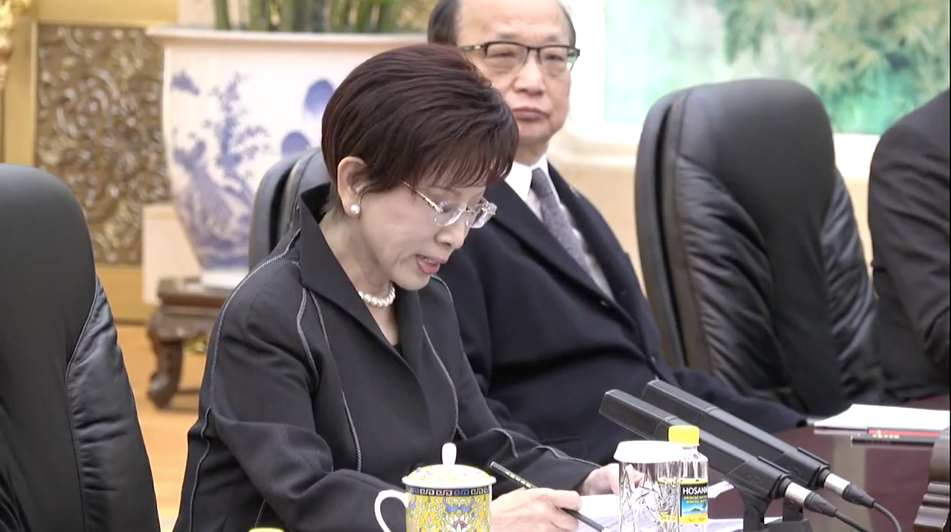 Hung during the meeting with Xi. Photo credit: Hung Hsiu-Chu
Hung during the meeting with Xi. Photo credit: Hung Hsiu-Chu
Hung has indicated a desire to meet with Xi for some time, with public statements suggesting that the KMT would not hesitate to take cross-strait relations into its own hands because of its lack of faith in the Tsai administration to maintain peace with China. Though the focus of the forum was originally economic development between Taiwan and China, given the recent deterioration of ties between Taiwan and China since the Tsai administration took office, the focus of the forum has been changed to “peaceful cross-strait development.” Hung had previously met Xi as part of Eric Chu’s delegation to Beijing in March 2015.
Internal Controversy Within The KMT?
BEFORE THE Hung-Xi meeting, it became a matter of controversy within the KMT as to whether Hung would continue to uphold an interpretation of the 1992 Consensus as meaning “One China, Two Interpretations” or attempt to jettison the “Two Interpretations” aspect in favor of only “One China”—the so-called “One China Principle.” During her stint as presidential candidate of the KMT, Hung attempted to assert something she referred to as “One China, Same Interpretation” as an “advanced version” of the 1992 Consensus. This suggests that Hung has no objection to the immediate unification of Taiwan and China. It was also believed that Hung would try to propose a peace accord with China, something she also suggested during her presidential run.
Yet this led to blowback from none other than former Taiwanese president Ma Ying-Jeou. Ma seemed to think this would irreparably damage the KMT’s reputation with the Taiwanese public. Such statements by Ma are ironic, seeing as present blowback against the KMT began under the Ma administration, with policies aimed at facilitating the economic integration of Taiwan and China which brought Taiwan too close to China for comfort for members of the public. This ultimately culminated in the 2014 Sunflower Movement occupation of the Legislative Yuan. And Ma’s actions paved the path for Hung’s meeting with Xi, Ma having himself jettisoned the “Two Interpretations” aspect of the 1992 Consensus in favor of the “One China Principle during his own meeting with Xi.
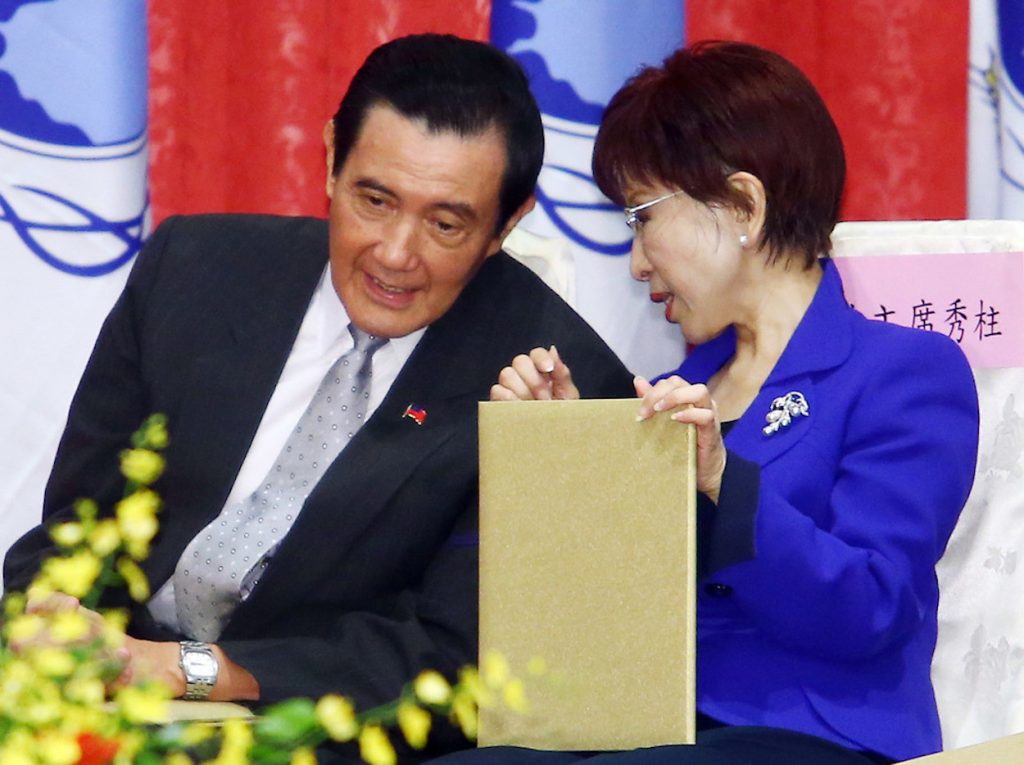 Photo credit: UDN
Photo credit: UDN
Before her meteoric rise from obscurity to becoming for a time the presidential candidate of the KMT and then its chairman, Hung was thought of as a member of the “Mainlander” faction within the KMT led by Ma. It seems that Hung now has sufficient clout to resist Ma, now occupying the position of KMT chairperson that Ma previously occupied. Deep Blue diehards are at the helm of the party under Hung, but it was Ma’s actions which ultimately allowed them to take control of the KMT.
Factional conflict will likely continue within the KMT, with future challenges to Hung’s leadership by former vice president Wu Den-Yih. While Hung being able to achieve a meeting with Xi and the resultant perception that Hung has the favor of China may increase her standing among some elements of the KMT, Hung’s meeting with Xi will also become political ammunition for her opponents. Regardless of the claims of a higly suspect poll released by the KMT, the party being able win back the Taiwanese public seems unlikely, as the public view of the KMT as dangerously pro-China will not fade. If Ma is himself attempting to reverse course from policies he himself set the precedent for, the public has not forgotten his actions of just several years ago and the rise of Hung is perceived rightly as the logical culmination of Ma’s policies.
The Hung-Xi Meeting
AND INDEED, there was not many surprises from the public transcript of the Hung-Xi meeting. While a closed door meeting, as expected, it is reported that Hung did not refer to the “Two Interpretations” aspect of the 1992 Consensus or even refer to the existence of the Republic of China. Likewise, Hung proposed a peace accord with China, stating that this was necessary to combat separatism, and that while the KMT finds itself in the position of a political opposition at present, the KMT and CCP have a shared responsibility to lead forward peaceful development.
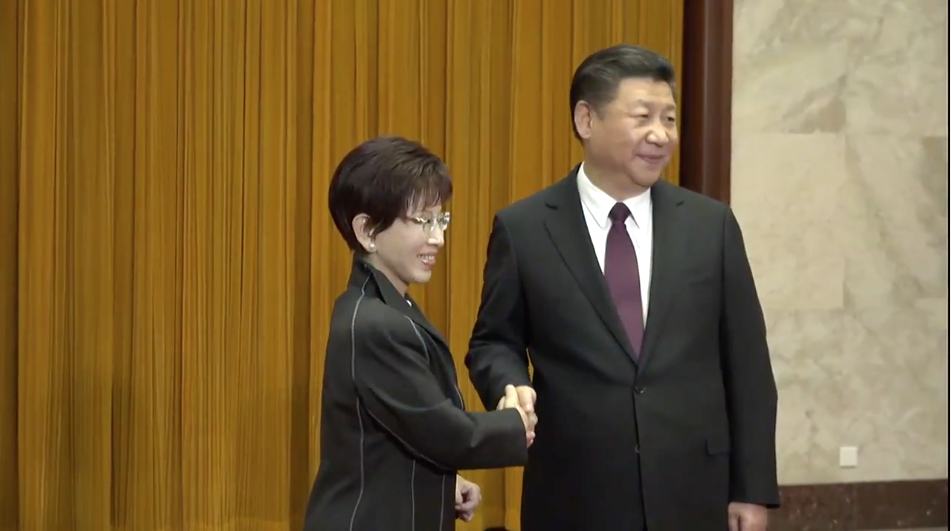 Photo credit: Hung Hsiu-Chu
Photo credit: Hung Hsiu-Chu
On the other hand, Xi’s comments expressed approval of Hung’s proposal and suggested further study to realize this, but shied away from anything more concrete. Obviously, it is that Hung cannot legally negotiate a treaty with China on her own, having no authority to do so, and so Xi can only go so far in expressing approval of the KMT’s actions.
All of this was largely expected. But if there was anything to be taken away from the meeting, we might ask, who exactly was Hung’s target audience for her speech? With numerous references to the threat of Taiwanese independence and the need to combat separatism, as phrased in ideological language the CCP is fond of throwing around, Hung’s eyes were probably set only on a Chinese audience. Notably, Ma Ying-Jeou did not lash out at Taiwanese independence during the public remarks of his meeting with Xi Jinping last year as Hung did, returning to the point several times during her comments.
The CCP will likely continue to pin its hopes to the KMT to act as its political proxy in Taiwan, despite the decline in political fortunes of the KMT and the KMT’s current internal crisis. China may prefer Hung’s leadership of the KMT to other contenders, given that Hung openly expresses the pro-unification views that China likes to see.
But China is likely aware of internal splits within the KMT and that Hung is a contentious figure not just with the Taiwanese public, but within the KMT itself. It is to be seen whether the CCP will switch to a more intelligent strategy of attempting to split reformist elements of the KMT from its current leadership under Hung, attempting to co-opt increasingly conservative elements of the DPP, or whether it will back Hung to the hilt.
Questions For The Tsai Administration?
ANOTHER IRONIC outcome of the Hung-Xi meeting is that the Tsai administration would urge Hung before the meeting to assert the existence of the ROC while in China and call on China again to acknowledge the ROC after the meeting. This reflects to what extent the DPP, which historically has bucked against the ROC framework, now finds itself in the position of defending the ROC. On the other hand, while the KMT has clung to the ROC framework as a way of less directly asserting pro-China views, Hung would seem to negate the existence of the ROC altogether in her exchange with Xi.
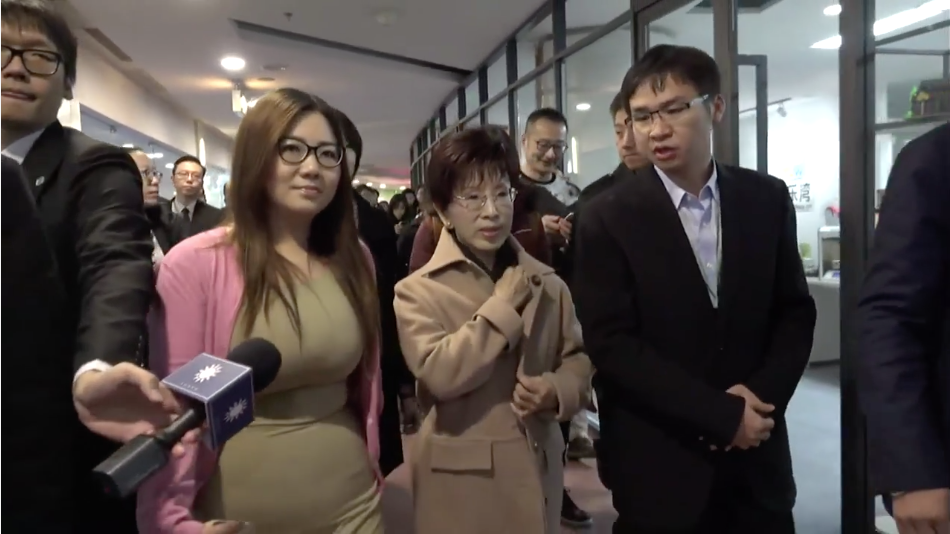 Photo credit: Hung Hsiu-Chu
Photo credit: Hung Hsiu-Chu
This is probably indicative of the overall shift towards the “Blue” end of the Taiwanese political spectrum by both the KMT and DPP in present Taiwanese politics. The KMT has slid towards increasingly extreme pro-unification views, while it is now the DPP which defends the ROC framework. Such would be the realities of accommodation to the political establishment by a party which was once defined by its identity as the political opposition.
But with the looming possibility of splits within the KMT, this may open the path for elements of the pan-Blue camp, such as the “Taiwanese” faction of the KMT, to break off and join with the DPP. The Tsai administration has notably courted members of the pan-Blue camp for government positions that have to do with cross-strait ties or international relations, such as appointing James Soong of the People First Party as Taiwan’s APEC representative or contemplating Wang Jinpyng for head of the Straits Exchange Foundation.
Perhaps the Tsai administration may believe the KMT and pan-Blue camp’s claims that it is the only political force in Taiwan able to successfully conduct relations with China to some extent, though the Tsai administration may be trying to drive a wedge between conflicting factions of the pan-Blue camp. This remains to be seen, although Tsai hopefully will not take the wrong lesson from the Hung-Xi meeting and attempt to make amends with Hung in the hopes that this will allow her meet with Xi Jinping herself. Rather, the DPP would be better served by leveraging on the fact that Hung’s meeting with Xi and proposing a peace treaty on her own could be legally construed as treason and is undemocratic, with one political party deciding that it has the right to negotiate for the nation as a whole.
Namely, Tsai has herself indicated a willingness to meet with Xi Jinping in the past, having a surprisingly muted reaction to the meeting, and stating shortly after Ma-Xi meeting in November 2015 that she hoped to meet with Xi in Beijing in their capacities as the heads of state of the ROC and PRC. Likely, Tsai’s muted reaction to the meeting was because she did want to be attacked for hypocrisy in case she met with Xi herself in the future. It was also an open policy of Tsai’s during past elections that she wished to sign the China-led RCEP trade agreement, continuing Ma era policies of signing trade agreements with China, even if many of her supporters failed to pick up on this. Once in office, the Tsai administration originally still wished to sign the CSSTA trade agreement with China that had been hotly demonstrated by the Sunflower Movement, and it would take further public outrage to get it to back down from that plan.
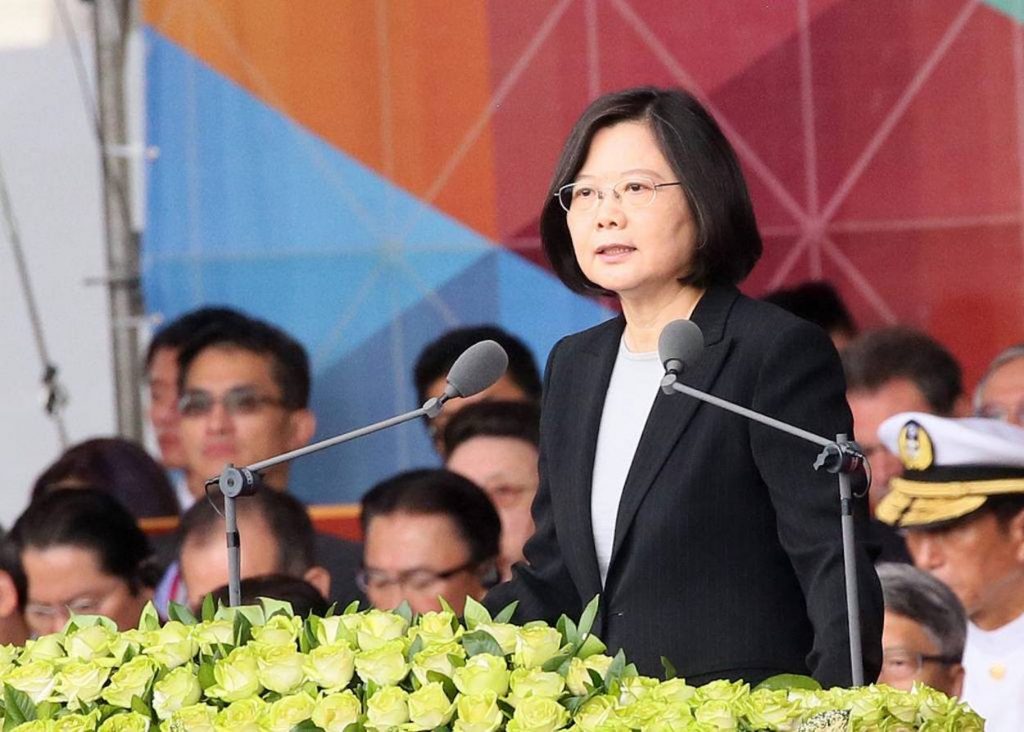 Tsai Ing-Wen during her National Day address. Photo credit: Presidential Residence
Tsai Ing-Wen during her National Day address. Photo credit: Presidential Residence
With China suspending communications with Taiwan over Tsai’s refusal to explicitly acknowledge the 1992 Consensus, despite referring to the “historical facts of the 1992 talks”, some questioned whether Tsai’s National Day address in early October would reverse course to acknowledge the 1992 Consensus. But though still not backing down on the issue, Tsai’s National Day Address would in fact contain an appeal for China to reopen communications.
With lack of any real public response to the Hung-Xi meeting, this probably is only another nail in the coffin for the KMT, whose extremist pro-China policies do not surprise the public at this point. This could also be a sign of domestic issues taking priority over cross-strait issues for Taiwanese at present, as was evident in the results of 2016 elections. For example, youth activists did not organize to demonstrate the Hung-Xi meeting, instead prioritizing demonstrating plans to cut public holidays by the Tsai administration.
And, indeed, the nature of the Hung-Xi meeting is itself telling of the nature of the KMT’s attempts to build ties with China, with Taiwanese media being refused access to cover the meeting and the meeting itself taking place behind closed doors. This occurred that the meeting was political theater to begin with, seeing as high-level KMT and CCP officials can be in communication anytime and do not need to meet physically to communicate.
We will see as to the actions of the KMT going forward. Ultimately, the meeting seems to have accomplished little for either the KMT or CCP, and has not revealed anything new we did not already know beforehand. But it may in fact be that a poor response from the DPP or a failure of the DPP to manage international perceptions of the meeting can still be a threat to maintaining Taiwan’s de facto independence.

